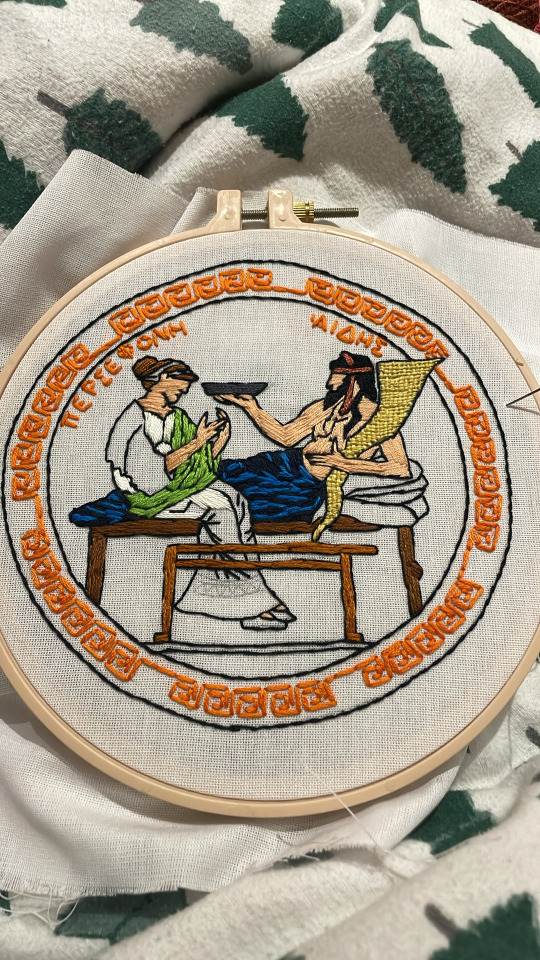#persephonegreek
Explore tagged Tumblr posts
Text
My next embroidery project. This time on Hades and Persephone from a vase. This is one of my favorite stories from Greek mythology.
Part2

#hades and persephone#hades#hades greek mythology#hades greek god#ancient greek mythology#ancient greek#persephades#persephone#persephonegreek#greek mythology#hand embroidery#hand stitching#flowers
227 notes
·
View notes
Text

Persephone
Greek goddess of Spring and the Underworld
Persephone was also titled Kore (the Maiden) as the goddess of spring's bounty. The most popular myth including this goddess was of course the story of young Persephone playing with her nymph friends before being seized by Hades and brought to the Underworld. When Hades had seen Persephone, he immediately desired her and was granted Permission by Zeus to take her. So Hades chased the young goddess in his chariot and seized her up to him as she cried for help. It is in most versions, that Persephone fought against Hades’ advances but is tricked into eating the pomegranate seeds. After eating from the pomegranate, Persephone is rescued, but can only stay with her mother for two-thirds of the year, while she must spend one-third with Hades. She goes and laments to her mother after her rescue, with Hekate agreeing to stay and accompany her. During the absence of her beloved daughter each year, Demeter mourns, causing the life of the Earth to fade.
Apollodorus in the following passage summarizes the contents of the Homeric Hymn to Demeter. Pseudo-Apollodorus, Bibliotheca 1. 29-33 (trans. Aldrich) (Greek mythographer C2nd A.D.):
“Plouton [Haides] fell in love with Persephone, and with Zeus’ help secretly kidnapped her. I begin to sing of rich-haired Demeter Semne Thea (Reverend goddess) - of her and her trim-ankled daughter [Persephone] whom Aidoneus rapt away, given to him by all-seeing Zeus the loud-thunderer. Apart from Demeter Lady of the golden sword (khrysaoros), Giver of glorious fruits (aglaokarpos), she was playing with the deep-bosomed daughters of Okeanos and gathering flowers over a soft meadow, roses and crocuses and beautiful violets, irises also and hyacinths and the narcissus, which Ge (Earth) made to grow at the will of Zeus and to please the Host of Many [Haides], to be a snare for the bloom-like girl…The girl was amazed and reached out with both hands to take the lovely toy; but the wide-pathed earth yawned there in the Nysion plain, and the lord, Host of Many, with his immortal horses sprang out upon her…
Hades caught her up reluctant on his golden car and bare her away lamenting. Then she cried out shrilly with her voice, calling upon her father, the Son of Kronos [Zeus], who is most high and excellent. But no one, either of the deathless gods or of mortal men, heard her voice, nor yet the olive-trees bearing rich fruit: only tender-hearted Hekate, bright-coiffed, the daughter of Persaios, heard the girl from her cave, and the lord Helios (the Sun), Hyperion’s bright son, as she cried to her father, the Son of Kronos [Zeus]. But he was sitting aloof, apart from the gods, in his temple where many pray, and receiving sweet offerings from mortal men. So he, that Son of Kronos [Haides], of many names…was bearing her away by leave of Zeus on his immortal chariot–his own brother’s child and was all unwilling.
And so long as she, the goddess, yet beheld earth and starry heaven and the strong-flowing sea where fishes shoal, and the rays of the sun, and still hoped to see her dear mother [Demeter] and the tribes of the eternal gods, so long hope calmed her great heart for all her trouble; and the heights of the mountains and the depths of the sea rang with her immortal voice: and her queenly mother heard her. Thus Demeter dressed in mourning robes and frantically searched for her daughter with the help of Hekate for nine days.
When Zeus commanded Plouton to send Kore [Persephone] back up, Plouton gave her a pomegranate seed to eat, as assurance that she would not remain long with her mother. With no foreknowledge of the outcome of her act, Persephone consumed it. Askalaphos, the son of Akheron and Gorgyra, bore witness against her, in punishment for which Demeter pinned him down with a heavy rock in Hades’ realm. But Persephone was obliged to spend a third of each year with Plouton, and the remainder of the year among the gods.”
Roles: Persephone holds a role as the dread queen of the Underworld, which tradition had it forbidden to speak her name. This tradition comes from her conflation with the very old chthonic goddess Despoina (“[the] mistress”), whose real name could not be revealed to anyone except those initiated into her mysteries. In Homer’s epics, she appears as the formidable and venerable queen of the shades, who carries into effect the curses of men upon the souls of the dead. The story of Persephone having to marry Hades is thought to be written as inspired from the grief Ancient Greek mother’s faced when their daughters were taken away by their new husbands without warning.
Appearance: Persephone appears in her late 20′s, is elegant, has pale skin, long black hair, and hazel eyes. She tends to wear long, dark purple dresses in the ancient Greek style.
Personal experiences: Persephone is withdrawn around those she does not know, but very friendly and often upbeat with those she is friends with. She is generally introverted but can also be quite rebellious. Overall, however, she is kind and friendly, making her easily approachable but becomes quickly angered if Hades/Pluto is mentioned. Persephone manages to come across as both youthful and serious due to her time in the Underworld and because of her trauma. She enjoys helping those who are in need and being able to lend them advice, though also showing them how to be strong. But this goddess is not one to be crossed. She can even be quite cold when angered, but she is usually understanding. This lovely goddess also has a soft spot for the Dead, as she guides their trials in the Underworld until they can move on to Elysium.
In my workings with Persephone, she is not actually married to Hades, but was held by him against her will. It’s true that she was kidnapped by him, but this was moreso a very traumatic experience in which Hades held her captive for many ages. He had done this not out of sadism, but out of desperation since he was unable to find a companion; but this does not justify his actions since he soon ended up taking her by force. After a long time, Persephone finally escaped him and left to live on her own elsewhere, with Hades seeking to repent for his actions. It’s not something she enjoys talking about due to all that Hades did to her, so please be gentle with her regarding this story. Also, due to her being kept in the Underworld for so long, she is moreso connected to death now than life. Persephone lives within a beautiful palace that has black and purple colours.
| Some of her epithets |
Enodius (At the cross-roads)
Agní (Holy; Pure)
Ánassa (Queen)
Anthæsphória (Of the flowers)
Dáeira (She who knows)
Karpophóra (Fruit-bearer)
Kædní (Noble and trustworthy)
Khthónia (Earthly)
Kore (Maiden)
Praxidíki (She who exacts retribution for injustice)
Sóhteira (She who helps)
Offerings: Dry red wine, mead, pomegranate juice, goat milk, lamb meat, cheese from lamb, pomegranates, wheat, green and red bell peppers, beetroot, lentils, peas, broad beans, oregano, basil, mushrooms, haystacks, grain, pine needles, chocolates, tarts, dead flowers (especially purple ones), flower crowns, honeycombs, spirit communication tools, purple candles, poetry, prose, artwork, silver jewelry, floral perfume, purple silk, rose quartz, black tourmaline, desert rose, moss agate, white howlite, black marble, and incense of lavender or amber musk.
3K notes
·
View notes
Text
Finally, I'm done

#hand embroidery#hand stitching#textile art#textiles#emboridery#ancient greek#hades#hades and persephone#hades greek mythology#hades greek god#persephonegreek#persephades
63 notes
·
View notes
Text

Finally, progress at work. Part 3
The color of Hades outfit is inspired by Disney's Hercules. Persephone's color is inspired by the musical Hadestown.
#hand embroidery#hand stitching#flowers#textile art#textiles#emboridery#ancient greek#persephonegreek#hades and persephone#persephone#persephades#hades greek mythology#hades greek god#hadestown#lore olympus#hades disney#hades
24 notes
·
View notes